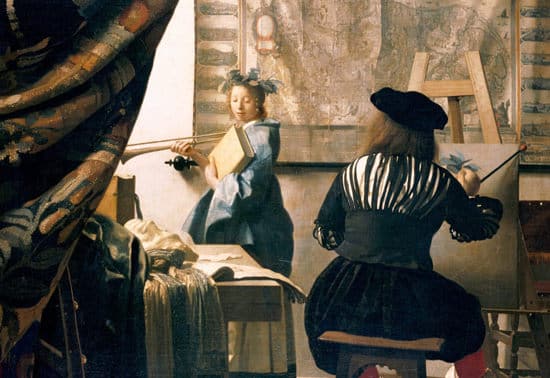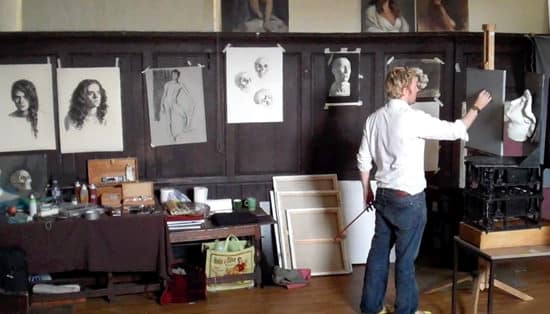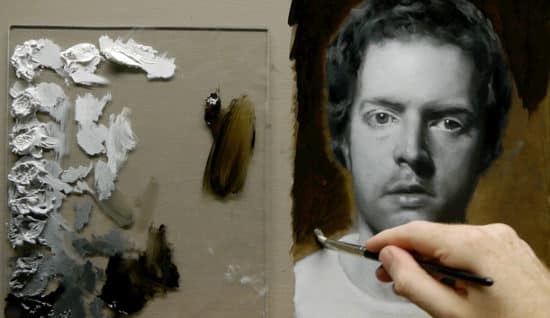
The Art of Painting (detail), Johannes Vermeer, 1666
You might think you need more time, or the perfect paint brand or a new brush.
When the weekend comes and you’ve finally managed to find some ‘you’ time, the blank canvas stares back at you and the finished portrait, you so desperately wanted to achieve, seems a world away.
Your motivation is high, your drawing’s good but the jump from pencil to paint has hit a wall.
Flicking through an art magazine or shopping for a new paint colour suddenly seems like an attractive idea.
You’ll start next week when you’ve got the exact colour you need.
But what if these actions are holding you back?
What if you forced yourself to try and achieve more with less, give yourself some constraints and your portrait painting could make giant leaps forward?…
1. The Art of the Start
One of the biggest regrets you can have in any creative endeavour is not starting.
It can eat you up and days, months and years can pass by before you give yourself time, and permission to start.
Lack of time can seem like the perfect excuse, kids, work commitments…life.
But giving yourself permission can be the real truth.
Permission to start.
Permission to fail.
Permission to call yourself an artist.
2. Having a method
I always wanted to paint portraits but I put it off, I was worried about how they would turn out, and compared to the Old Masters I’d admired so much, it seemed like an overwhelming challenge.
Would everyone laugh when they didn’t look like the sitter?
So I continued painting abstracts professionally, they were selling well and it was what I was known for.
But the portrait bug was just buried deeper, it was the biggest mistake I made.
Then one evening me and Vanessa went to dinner at a friends house, both fellow artists.
After dessert, Warren excitedly showed us a wedding present they’d been waiting for 10 years. It was a life-size, double portrait a friend of theirs had painted, but in classic bohemian style, the artist only owned a motorbike and had never made it up the M6 to deliver it.
It was so impressive that a real, alive, ordinary person had created this work on such a grand scale and it had such an emotional impact on our friends, it couldn’t fail to inspire me.
The very next day I went to my studio and Vanessa became my first unwilling sitter for a full technicolor portrait, my approach was, to say the least, erratic!
The error of my ways

Studying sight size portraiture at The Sarum Studio with Nick Beer
From a list of paint colours from one book to a brush recommendation from another tutor and never mind the many hours spent in museums studying the paintings first hand.
I developed my own style… but they took hours and hours and the process was painful, the results…. just o.k.
So I then took a new creative approach, 20 colours, blaring Classical music and a livener of whiskey, inspiration should take over… well it sort of did.
I did produce a lot of portraits, some Award-winning, so not too shoddy – but something was still missing.
The subtleties of tone and smokiness of the Old Masters kept alluding me, so I decided to go to the source and head for Florence, Italy.
It was here I had a breakthrough, courtesy of Maestro, Micheal John Angel founder of the Angel Academy of Art, Florence. I’d been lucky enough to win a Queen Elizabeth Craft Scholarship to study there and also sight-size portraiture at The Sarum Studio, Salisbury with Nick Beer (senior instructor at the Charles Cecil Studio, Florence)
It was on this journey that I learnt the error of my ways.
The complicated recipe I’d created for myself was all wrong, I’d been using too many colours and working too hard.
How come no-one had told me this before? I’d wasted so much time and energy.
This was the inspiration to create this resource, to help other aspiring artists to not make the same mistakes I did.
Creative constraints
American realist painter Chuck Close wanted to challenge himself in his early painting career, so in the early 1960’s he made a choice.
He decided to start a new epic series of paintings (some were nearly 9ft-high) with one key ingredient missing….he threw away his paintbrushes.
This forced him to work within the boundaries of creating a painted image without using the one seemingly essential tool of the trade.
But his results were astounding.

“Frank”, Chuck Close, 1969, Acrylic on canvas.
He developed a technique akin to that of printmakers, using a 3 colour range to build up his paintings and used an airbrush rather than a paintbrush.
He broke down the process and tackled the subject with a methodical approach.
“If you’re overwhelmed by the whole, break it down to pieces.”
Chuck Close
However, this self-inflicted constraint wasn’t the only obstacle he faced in his painting career. During the mid-eighties, at the height of his success, he suffered from an illness which left him confined to a wheelchair.
Did this stop his productivity?
No, he learned to adapt. He went back to the paintbrush, this time having it strapped to his hand.
Instead of working on a smaller, more manageable scale he installed a forklift to raise and lower him. With each painting taking between four months to a year to complete, every day he had to show up and paint.
“The advice I like to give young artists, or really anybody who’ll listen to me, is not to wait around for inspiration. Inspiration is for amateurs; the rest of us just show up and get to work….You feel like you need this great idea before you can get down to work, and I find that’s almost never the case.”
Chuck Close
Creative constraints can give you focus in your paintings.
Mastering Black & White Portraiture with Oils

Will Kemp, video still from the course
I’ve developed a resource to help other would be portrait painters who are just starting on their journey.
‘The Essential Guide to Portraits – Mastering Black & White Portraiture with Oils’ is a downloadable video course that guides you through the process of creating a realist self-portrait in oils, using a black and white photograph as a reference.
You will learn to work confidently with a limited palette, learn Classical techniques with Oil paints and lay the foundation for all future full-colour portrait success.
If you want to understand about creating powerful portraits you need to understand about contrast and tone. Chuck Close’s favourite artist is Vermeer, another master of Chiaroscuro – the play of light & dark.
It’s not easy, but by following the step-by-step process, you can achieve some remarkable results.
I’ve taken care to film everything from my perspective so I could ensure you can see exactly what I’m doing as we go through the entire portrait process.
Click here to learn more about ‘The Essential Guide to Portraits – Mastering Black & White Portraiture with Oils’
